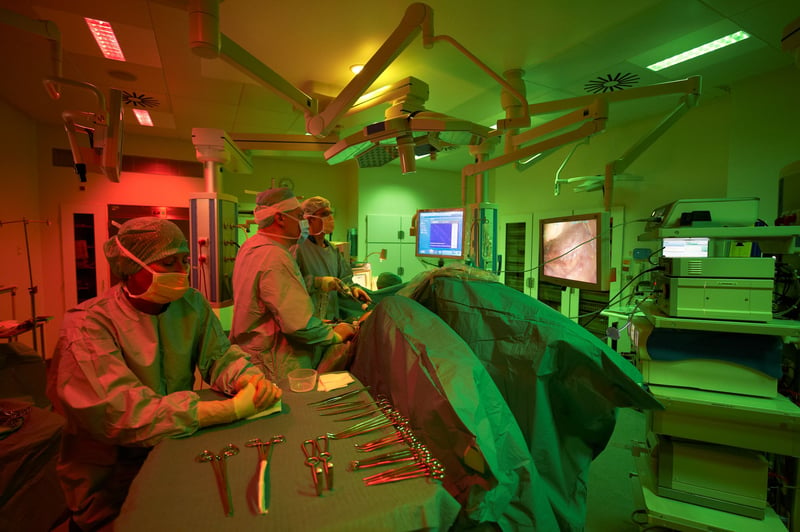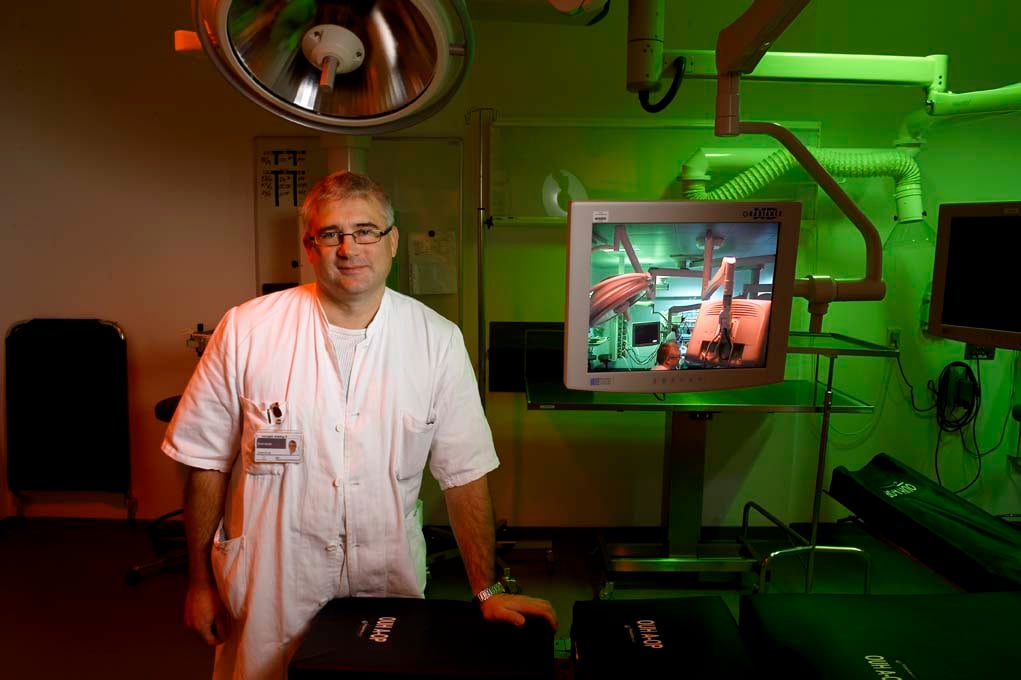Ergonomic Lighting serves as a prime example of user-driven innovation - born out of the desire for improved lighting conditions in operating rooms. Dr. Jesper Durup is the man who developed the idea and persevered until Ergonomic Lighting went into production and achieved commercial success. According to Durup, the idea would never have come to fruition without persistent insistence, targeted action, and risk-taking, visionary partners in the private sector. He is convinced that there are countless similar potentials for functional optimization. The way forward is interdisciplinary thinking, curiosity, and increased communication.
User-driven optimization
— Here in the hospital environment, we don't have much contact across specialties. They can be working on something brilliant a couple of floors below me, and I would never get wind of it, Jesper Durup begins, continuing:
— The segregated professional environment makes it harder to be innovative and dynamic. The importance of being able to make quick decisions cannot be underestimated. Here, we are weakened by the bureaucratic system. But it is possible with the necessary determination. The story of Ergonomic Lighting proves that ideas based on user optimization are worth pursuing. The ambition to do it better has been my driving force all along. Why settle for less? Because we truly needed better lighting in the operating rooms, where we used to work in semi-darkness all day long.
The solution was right there, waiting to be discovered.
— It all began when construction of ten new rooms at Odense University Hospital started back in 2004 – seven of which were operating rooms, two of which were considered high-tech. We had a desire to improve the lighting, but we weren't sure where to start. Lighting could fall under both the electrical contract and the medical equipment. We knew that the framework for the medical equipment came relatively late in the process, so I contacted the building coordinator to discuss the lighting while the project was still on the drawing board. There was some resistance – it certainly couldn't be done! During the same period, I visited the lighting manufacturer Riegens here in Odense. The occasion was a machine with ultraviolet light that could remove bacteria – and at the same time, I was given a tour of the factory. Along the way, I noticed some colored light tubes and was told that they were used to create different moods in a clothing store in Germany. That's where the idea of working with colored light in the operating room came about. The solution was right there, waiting to be discovered, Jesper Durup explains.
Lighting that is ideal for everyone
— Through Riegens, I got in touch with Martin Professional, who has great experience in lighting for the theater and music scene, Jesper Durup continues.
— They agreed to help with the development of a prototype, and I received input on the laws of colors, such as which colors have which effects, warm and cool colors, complementary colors, and more. The user-driven innovation meant that we simply tried different options in the room. The contrasts in the images on our screens became sharper in green light. As a contrast, red light was suitable and pleasant for the nurses on the floor. Violet light turned out to be good for grayscale screen images. That's how we tested intensity and colors. There had to be harmony in the room as a whole, while also catering to all sectors. The goal was to achieve optimal lighting for the surgeon, the anesthesiologist, the nurses on the floor, the patient, and the cleaning staff. This is where the ergonomic aspect comes in. You function better in the right lighting. Ergonomic Lighting is good light for everyone. Flexibility is the fundamental focal point, he emphasizes.

Visionary partners in collaboration
— The first prototype took its final form as a result of a constructive collaboration between Riegens and Martin Professional. Initially, it was Riegens who were visionary and willing to take risks. Director Frank Skovsager dared to invest and believed that the idea of Ergonomic Lighting could develop. He established contact with Martin Group, and both companies invested time and materials in the development. I took it upon myself to tackle the challenge of getting architects, medical technicians, and coordinators to accept our initiative, Jesper Durup says with a smile.
— We were working in one of the high-tech rooms that had been part of an EU tender. There are two leading providers in the market: Olympus and Karl Storz – and in our case, it was the latter who offered the most advantageous deal. Therefore, it was essential for Karl Storz in Germany to know how fantastic Ergonomic Lighting is. So, I went there and presented the idea together with Frank Skovsager from Riegens – and it ended with us agreeing on a formal collaboration with Karl Storz. Afterwards, a programmer came to Denmark and worked on getting the software to work so that the light could be controlled from the screen in the sterile area – and it succeeded. Ergonomic Lighting can be changed with a single touch from one operation to another. We have a flexible pre-programming, which is a simple user-friendly system. The starting point is that technology should be there to make things simpler and more efficient, he affirms.
Chromaviso takes the stage
— Over time, Ergonomic Lighting has undergone extensive product development. It is available in various versions depending on whether it is used for surgery, medical imaging, or endoscopy. Additionally, there is a separate user interface for placement outside of the sterile area. Today, Chromaviso markets and sells Ergonomic Lighting, with Riegens and Martin Professional as subcontractors. When it became clear that the idea was successful, Martin Professional had to assess whether they wanted to get involved. After careful consideration, they decided not to proceed, as they felt they lacked sufficient experience in the medical field. However, my contact at Martin Professional, Anders Kryger, believed in the idea so much that he quit his job to pursue it. Together with Claus Puggaard, he started Chromaviso. Today, my role is primarily as an advisor, but I am still dedicated to spreading awareness about Ergonomic Lighting. I communicate with architects, doctors, nurses, researchers, hospital management, and medical technicians both domestically and internationally. Ergonomic Lighting is based on user experiences, and that is a powerful asset to have, explains Jesper Durup.
Hard facts and soft values
— When I give lectures, I emphasize both the hard facts and the soft values surrounding Ergonomic Lighting. It creates optimal working conditions, enhances detail, and can be customized individually. As soon as I mention the well-being in the room and the "democratic" benefits for all functions, I can see that women are buying into the idea. Men, on the other hand, are more critical. They want hard facts about improved image quality and the possibility of central control from the sterile area. Ideally, there would be clinical evidence that Ergonomic Lighting reduces the risk of errors compared to traditional lighting, where the lights are turned down low. However, those statistics have not been collected yet, says Jesper Durup.
Enormous potential
— There is also an economic aspect to consider, with a reduced number of sick days due to improved well-being in rooms with Ergonomic Lighting. However, we don't have any statistics to support this yet. It requires a larger statistical data set, which has not been collected yet. But it's coming - the spread of Ergonomic Lighting is well underway. You can find it in over 50 rooms around the country, as well as in several locations in Sweden, the Faroe Islands, and France. At the same time, more and more specialties are being considered. Ergonomic Lighting is suitable everywhere where screens are used and there are zone-divided work situations. Intensive care units, for example, would be an obvious place where better environments and flexible solutions could be created. But also, ear, nose, and throat surgery or gynecology. The potential is enormous - and the development is well underway. But now it is Chromaviso who is leading the way - and they are doing it well. The public sector could learn a thing or two from their dynamic and development-oriented approach - it leads to new initiatives, and that is what we need, concludes Jesper Durup.

Chief physician Jesper Durup, from the Surgical Department A at Odense University Hospital, graduated in 1989 from OUH and specializes in surgical gastroenterology and pediatric surgery, with a particular interest in laparoscopic surgery and surgical ultrasound.

